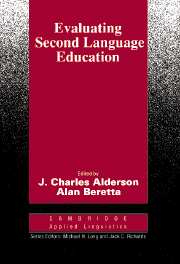Book contents
- Frontmatter
- Contents
- List of contributors
- Series editors' preface
- Acknowledgements
- Introduction
- I EVALUATION OF LANGUAGE EDUCATION: AN OVERVIEW
- II CASE STUDIES OF CURRENT PRACTICE
- Chapter 1 Insiders, outsiders and participatory evaluation
- Chapter 2 Evaluating a program inside and out
- Chapter 3 The ‘independent’ evaluation of bilingual primary education: a narrative account
- Chapter 4 Issues in evaluating input-based language teaching programs
- Chapter 5 Program-defining evaluation in a decade of eclecticism
- Chapter 6 Evaluation of classroom interaction
- Chapter 7 Moving the goalposts: project evaluation in practice
- Chapter 8 What can he learned from the Bangalore Evaluation
- III GUIDELINES FOR THE EVALUATION OF LANGUAGE EDUCATION
- Appendices
- Author Index
Chapter 2 - Evaluating a program inside and out
from II - CASE STUDIES OF CURRENT PRACTICE
Published online by Cambridge University Press: 05 October 2012
- Frontmatter
- Contents
- List of contributors
- Series editors' preface
- Acknowledgements
- Introduction
- I EVALUATION OF LANGUAGE EDUCATION: AN OVERVIEW
- II CASE STUDIES OF CURRENT PRACTICE
- Chapter 1 Insiders, outsiders and participatory evaluation
- Chapter 2 Evaluating a program inside and out
- Chapter 3 The ‘independent’ evaluation of bilingual primary education: a narrative account
- Chapter 4 Issues in evaluating input-based language teaching programs
- Chapter 5 Program-defining evaluation in a decade of eclecticism
- Chapter 6 Evaluation of classroom interaction
- Chapter 7 Moving the goalposts: project evaluation in practice
- Chapter 8 What can he learned from the Bangalore Evaluation
- III GUIDELINES FOR THE EVALUATION OF LANGUAGE EDUCATION
- Appendices
- Author Index
Summary
Introduction
The following study was designed to investigate the two major approaches to program evaluation: quantitative, experimental (in the traditional sense of the term) evaluation and qualitative, naturalistic evaluation. The data came from the University of Guadalajara (UdeG)/University of California, Los Angeles (UCLA) Reading English for Science and Technology (REST) Project. This project was initiated in 1985 as a part of an agreement for academic exchange between the UdeG and UCLA. At present, UCLA assists in the recruitment of teachers from the United States, but the project is managed entirely by UdeG personnel. There are plans to use the model curriculum developed by the REST Project elsewhere in the UdeG.
The data from the first year of the REST Project will be used to investigate and make recommendations concerning the methodology of program evaluation rather than to evaluate the REST Project per se. No ultimate judgments of the REST Project will be presented here. Instead, the focus and conclusions of this study will be on the use of quantitative and qualitative data and their associated methods of analysis in the evaluation of language teaching programs in general.
Several methods were identified for each of the two general approaches being investigated in this study. The basic research design for the quantitative approach used in this study is the nonequivalent control group (NECG) design. This was chosen because of the nature of the REST setting (primarily the inability to randomly select and assign to program and nonprogram conditions) and because it seems to be the most feasible design for the majority of educational program settings.
- Type
- Chapter
- Information
- Evaluating Second Language Education , pp. 61 - 99Publisher: Cambridge University PressPrint publication year: 1992
- 12
- Cited by



